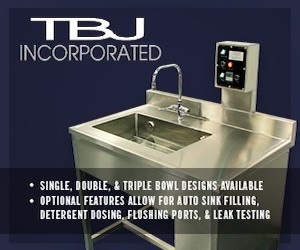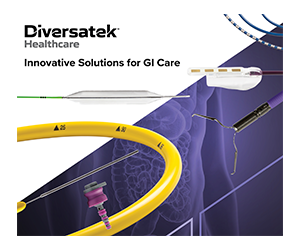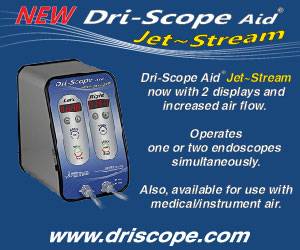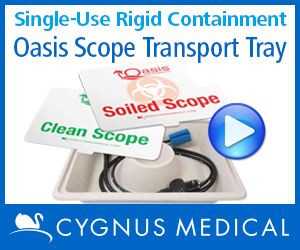By Erica Smith, MBA, and John Sullivan
The sterile processing department (SPD) and healthcare professionals responsible for cleaning, reprocessing, and sterilizing instruments to treat patients, play a daily but vital role in the health care system. Keeping patients healthy and reducing the risk of healthcare-acquired infections (HAIs) is the main goal.
While practitioners are taught to carefully follow the instructions for use (IFUs) when cleaning anything from a simple set of scissors to a complex endoscope, technicians should not forget about minimizing the risk of infection for themselves. This is a vital component of the infection prevention process. By taking the following steps, healthcare professionals can help keep everyone healthy and safe from infections.
Clothing
Any item of clothing worn while cleaning or reprocessing instruments should never be worn outside of a facility, and facilities should provide the basic clothing, as well as an area to change, before and after a shift. Individuals cleaning instruments or working in the SPD should always wear long sleeves. If clothing becomes soiled at any time during the shift, change immediately as part of the infection control process. Clothing should also include non-skid shoes and should only be worn in the facility.
Head Coverings
In areas in which instruments are being cleaned, individuals should wear head coverings and a disposable bouffant cap. If a reusable head covering is used, be sure to clean it daily and keep it covered by a separate, single-use disposable head covering that is changed between procedures. If the tech has a beard, a beard covering must be worn.
Face Masks
An important part of personal protective equipment (PPE) is the face mask. A minimum American Society for Testing and Materials–rating of level 2 should be worn, and the outer layer of the mask should be fluid resistant. Ensure the face mask fits over the nose and mouth and extends around the chin. There should be minimal gaps to ensure full protection. Also change face masks frequently throughout the day.
Along with face masks, proper eyewear/goggles should be worn, and covered with a face shield that extends down past the chin for best protection.
The person reprocessing the instruments should wear a fluid-resistant apron, gown or jumpsuit that is approved to be worn in a decontamination area.
Gloves
Gloves specifically approved for use in healthcare decontamination areas must be worn. Double gloving should also be part of the standard process. When choosing a glove, consider the following:
- degradation rating
- breakthrough time
- permeation rate
The outer glove should be designed specifically for instrument reprocessing. These gloves are thicker, designed to help protect a tech’s hand from sharp instrument components. They also have much longer cuffs that extend over a tech’s sleeves to keep fluids from penetrating the glove or sleeve.
Ensure the gloves are compatible with the chemicals used throughout the SPD area. Following the manufacturer’s IFU for both the gloves and chemicals can help ensure the gloves will stay intact throughout the decontamination process.
Donning PPE
When donning PPE, follow these steps:
- Gown
- Fully cover the body from neck to knees. Wrap the gown around the back.
- Do not take the shortcut and have the opening in the front of the body, as this opens the possibility for contaminated material to reach the undergarment of the professional.
- Mask
- Secure the mask around the face and ears. Ensure the face is covered from the bridge of the nose and around the chin.
- Form the flexible nose bridge.
- Ensure there is no gapping around the face.
- Goggle and Face Shield
- Place over eyes.
- Adjust the fit for unobstructed vision.
- Gloves
- Ensure the gloves extend to cover the wrists of the isolation gown.
Doffing PPE
When the instrument/device cleaning has been completed, proper doffing guidelines should be followed as recommended by the Centers for Disease Control and Prevention (CDC). These practices are just as important as the PPE selection itself. When removing PPE, assume that all pieces are contaminated, so take extra care to minimize the risks of touching potentially infectious material. Follow the below steps:
- Gowns and Gloves
- Grasp the gown in the front and pull away from the body, touching the outside with only gloved hands.
- While removing, fold the garment into itself with the outside inward.
- Dispose of PPE in the proper container.
- Goggles and Face Shields
- With gloves on, remove goggles from the back by lifting the headband and without touching the front of the goggles and/or face shield.
- If any of the equipment is reusable, place it in the proper bin for reprocessing.
- Mask
- Always consider the face covering to be contaminated. Never touch the front of the mask.
- Grasp the ties or elastic bands straps and pull carefully off the ear and away from the face.
- Dispose of the mask properly.
Once all PPE is removed, or if any time during the process hands become contaminated, wash hands immediately using an approved soap or an alcohol-based sanitizer. The CDC has a downloadable reference on proper PPE use, which includes donning and doffing diagrams.
Purchasing PPE
With the onset of COVID-19, new manufacturers of PPE have emerged. With this in mind, it is important to ensure that the PPE a facility uses has approval for the specific application. In some cases, PPE manufacturers may not have gone through testing to have their masks receive a 510K. Be sure to work with a trusted distribution partner to find the best quality PPE products.
Chemicals
PPE is vital in protecting staff from the chemicals used throughout SPD. These chemicals include presoak/holding solutions, cleaning and disinfecting chemicals, and high-level disinfectants or sterilants. Holding solutions or enzymatic solutions are meant to prevent bioburden from clinging to the instruments. The CDC states that it is necessary to remove any bioburden from instruments in order for proper sterilization (CDC, 2016).
Using presoak/holding solutions immediately after procedures should help ensure bioburden does not stay on the instrument during cleaning. Many presoak/holding solutions use enzymatic chemicals that have an Environmental Protection Agency (EPA) category 2 ranking, which means they could cause serious eye damage or skin irritation. This reiterates the importance of staff consistently wearing the correct PPE throughout the SPD process.
Next is the instrument washing process. These chemicals clean and disinfect the instruments before they undergo the autoclave for sterilization. There are two different methods of cleaning instruments: manual and automated. When staff are manually cleaning instruments, ensure all PPE is worn correctly and intact. Handling instruments manually can increase the chance of a sharps injury if the proper PPE is missing or torn.
Manual vs. Automated Cleaning
Manual cleaning is proper for fragile instruments that cannot be processed in ultrasonic cleaners and instrument washers. Ultrasonic cleaners and instrument washers are great for cleaning instruments with hard crevices. This helps automate the SPD process.
By utilizing automatic cleaning equipment, the risks of sharps injuries can be reduced. While not every instrument can handle being cleaned in this equipment, it is important to utilize at least one, if possible, to help clean crevices of certain instruments. Different chemicals can be used for the cleaning stage. Depending on the active ingredient, they typically have an EPA category 2 and category 3 ranking. Adverse reactions can include eye damage, irritation, and skin corrosion and irritation. Any staff managing these chemicals must ensure they are wearing and using their PPE correctly.
Sterilization
The last step is the sterilization process. Depending on the type, instruments that can withstand heat and steam can be sterilized in an autoclave. Instruments that cannot withstand heat or steam can be sterilized in low-temperature autoclaves or with a high-level disinfection/sterilant.
Low-temperature options may include ethylene oxide, or hydrogen peroxide plasma gas. High-level disinfectants can use glutaraldehyde, hydrogen peroxide, ortho-phthaldehyde, and other active ingredients. EPA-regulated surface disinfectant chemicals range from a category 1 to category 4 ranking. Category 1 chemicals are highly toxic, while category 4 chemicals are not acutely toxic.
Because of the different hazards that can be encountered during sterilization, it is important to ensure that staff maintain the correct procedures and use the correct PPE. However, even in light of this, the CDC found that nearly 44 percent did not wear their protective gowns, and 9 percent did not wear the correct gloves (CDC, 2018). The CDC also discovered that 17 percent have not received training, and 42 percent claimed their last training was more than 12 months prior (CDC, 2018). The lack of proper use of PPE and training can open the door for accidents or cross-contamination. The lack of training could stem from such challenges as consistent changes in guidelines, lack of staff to train, and training cost.
Despite these challenges, it is imperative to ensure training is completed. Consistent training and accountability will help prevent accidents and cross-contamination. Even when facilities have high turnover or temporary staff, providing consistent training to all current and new staff will help maintain a safer environment.
Depending on the type of pathogen, there could be a high risk of transmission. Training, proper technique, and PPE are there to prevent risk to the staff or other patients. According to Sullivan Healthcare Consulting, it is estimated that due to lack of proper technique, training, and PPE, the United States spends an average of $9.8 billion in treating hospital-acquired infections (HAIs) and surgical site infections (SSIs). With new pathogens continuously discovered, this number could potentially increase due to the transmission rate of the new pathogens. As new pathogens are discovered, techniques and training could change, just as they did with COVID-19. It is important to have the most recent technique guidelines and training implemented into the facility to help prevent the spread of infection.
Conclusion
In a busy department, it can be easy for certain steps to fall to the sidelines. Following instructions for use, using personal protective equipment correctly, and implementing and maintaining appropriate training for staff are key elements to help prevent the spread of disease throughout a facility.
PPE should be used as part of a comprehensive infection control program that follows CDC recommendations and guidelines from the Occupational Safety and Health Act of 1970 (OSHA) requirements, including the Bloodborne Pathogens (29 CFR 1910.1030), PPE (29 CFR 1910.132), and Respiratory Protection (20 CFR 1910.134).
Great resources are available to help design a PPE program, including ANSI/AAMI ST91 (the American National Standards Institute/the Association for the Advancement of Medical Instrumentation), and through the Society of Gastroenterology Nurses Association, Association of Perioperative Registered Nurses, and Health Sterile Processing Association of Healthcare Central Service Material Management.
We deliver care in a world where new pathogens are discovered constantly. By always following proper technique and maintaining training, facilities will be ready and prepared to help keep everyone safe when new pathogens may be discovered.
Erica Smith, MBA, is a surgical solutions manager at Henry Schein, Inc. She helps guide healthcare professionals in conducting proper infection prevention protocols throughout ambulatory surgery centers. She is completing her doctorate in public health and believes that by helping health care professionals improve their infection prevention processes, communities can receive better care.
John Sullivan is the director of sales for the Alternate Care Division at Crosstex (a member of the HU-Friedy Group and now part of Steris). Sullivan began his career as the Healthcare Channel Manager for Reckitt Benkiser, the creator of Lysol, and has been involved in sterility assurance for more than 20 years.
For references, visit www.endopromag.com.














